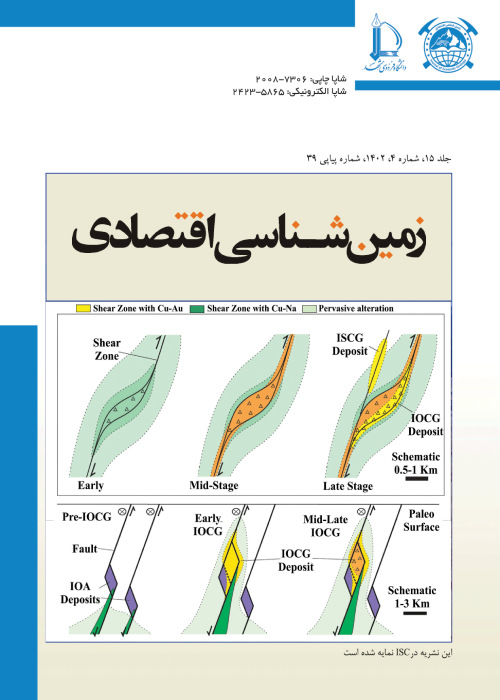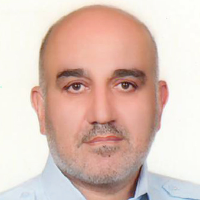Application of Variance-Distance exponential model in geochemical studies of zinc calamine ore deposit (Mehdiabad mining complex of Yazd)
Calamine Zn-Pb deposit (Mehdiabad, Yazd, Central Iran) is a mineable nonsulfide mineralization, located in the upper part of a volcano-sedimentary basin at intersection with erosion surfaces. From statistical viewpoint, geochemical distributions of trace elements due to volcanic-exhalative processes, may naturally be predominated by self-organized zonation in ore mineralized regions (Cheng et al., 2000; Mehrnia, 2017). Therefore, attention is paid to nonlinear distribution of particular elements to finding their spatial relations with concealed ore mineralization for prospecting sedimentary-hosted exhalative deposit (SEDEX). In this way, calculation and analysis of statistical coefficients is a necessary stage for prospection of the inter-relation of typomorphic elements. In cases where the erosion surfaces result in redistribution of supra ore elements, the approach of linear regression coefficient is not recommended, because progressive weathering usually hides the natural zonality of elements, as an expected criterion for hypogenic mineralization (Hassani-Pak, 2012). Our research approach which is to find a proper zonality of elements is based on nonlinear assessment of geochemical distributions for a case of epigenetic mineralization that seems to be related to deep/concealed SEDEX deposits.
Current research uses a variance-distance equation to modify the linear regression results as follows: (1)where Log (Vx) and Log (Dvx) are the logarithms of variances and distances respectively; and FD is the fractal dimension. A log-log plot is used to illustrate Vx and Dvx changes on horizontal (X) and vertical (Y) axes to obtain a distribution’s density function. By statistical concepts, FD is an independent variable from the central tendencies as well as distribution parameters. Meanwhile, a self-organizing property of geochemical distributions is geometrically dependent on fractal dimension changes on power-law’s log-log plots. For obtaining the natural geochemical zonation of Calamine’s path-finder elements, a set of lithogeochemical data has been used. Consequently, a total of 180 litho-samples of Calamine region were collected and interpolated to find the anomalous populations. A GIS-based software (Spatial Analyst) was used here to obtain geometric and statistical quantities which are necessary for variance-distance equation (Teymoorian-Motlagh et al., 2012). This soft-package works on ArcMap with the ability to export summarized data to other supplementary software packages such as Excel which are used to complete and present V-D log-log plots.At the second step, we used fractal dimension changes to identify the Brownian surfaces of elements. This surface usually contains a set of paragenetic elements which are found together within several correlated zonations with respect to their rate of activities in magmatic environments. A Brownian surfaces is formed of particular geometric locations of self-similar populations. When it changes between 2.5>FD>2, it represents scale-invariant continuity of distributions (Thorarinsson and Magnusson, 1990). In other word, this surface denotes the tendency of trace-elements to nonlinear distributions and it is geometrically related to a probable phase of mineralization in some epigenetic ore deposits.
Based on a variance-distance model for Calamine’s indicative and path-finder elements, six target areas are presented in a contoured prognostic map, which contains As, Zn, Cr, Sb, S, Co, Cu, Pb, Ni and Ag in a sequent. Order of this sequent is based on geometry of their Brownian surfaces. The largest surface belongs to As while the smallest one belongs to Ag and Cd. Among the elements which have reached the Brownian surface, As, Sb and Zn shared similar fractal parameters and extended at the background of other elements. Cr was the only element which did not follow the As, Sb and Zn backgrounds, because its geometrical location is independent of other elements. The mentioned target-areas which are marked on the prognostic map, have different scoring of mineralization potentials that is prioritized by considering zonation peculiarities of elements on fractal surfaces.
Fractal relationship of elements is conceptually different from what is generally stated in statistical models. Therefore, many elements which have desirable linear correlation with each other (relatively good condition for path-finding), are unfavorable as V-D models and vice versa. From a nonlinear perspective, a Poisson distribution is the most important criterion for analyzing coherency of elements in hypogenic environments. As a final result, we have illustrated that Brownian surfaces in As, Zn and Sb are extended well in the central and southeastern parts of Calamine, marking a proper relation of the structures with the host units during exhalative activities of the region. The high amount of these elements compared to the background indicates the effect of fluid flows and the penetration of mineralizing solutions under a supergene condition of the mine as well opening the fractures and fault systems.
- حق عضویت دریافتی صرف حمایت از نشریات عضو و نگهداری، تکمیل و توسعه مگیران میشود.
- پرداخت حق اشتراک و دانلود مقالات اجازه بازنشر آن در سایر رسانههای چاپی و دیجیتال را به کاربر نمیدهد.



